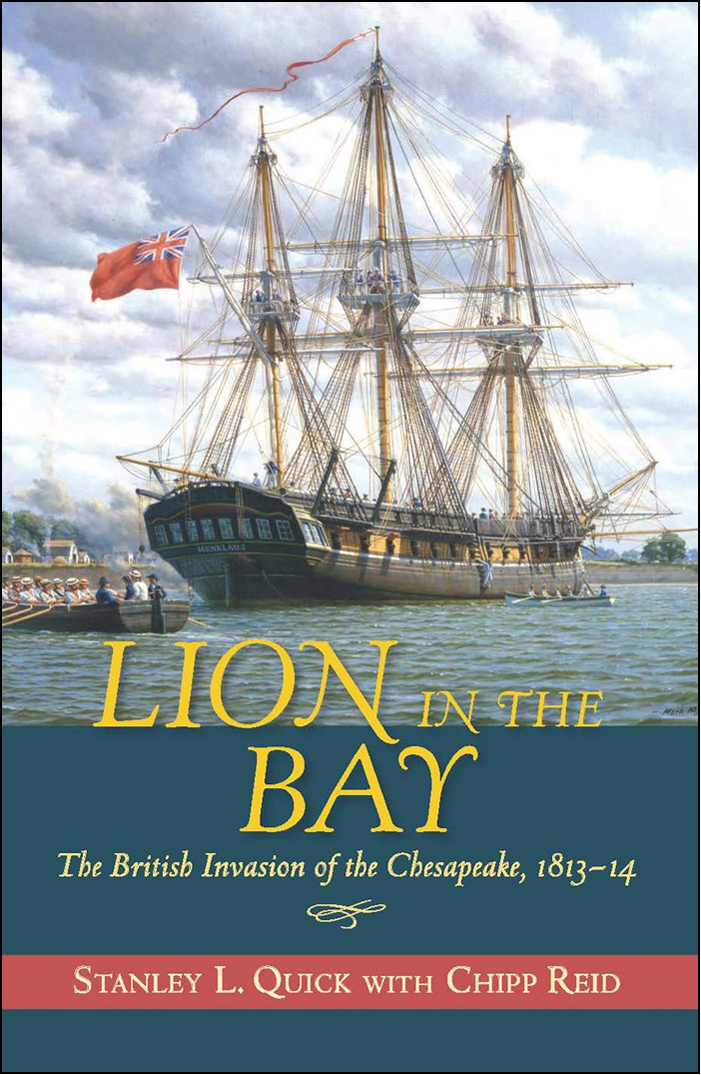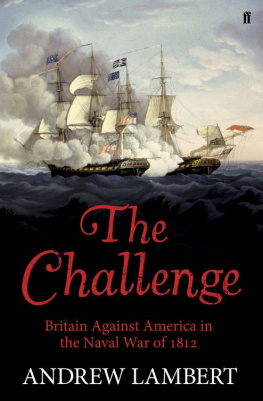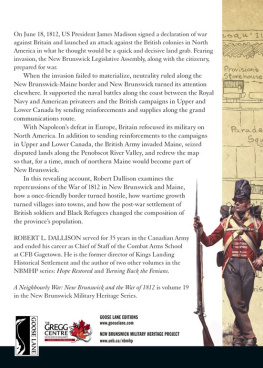


This book has been brought to publication with the generous assistance of Marguerite and Gerry Lenfest.
Naval Institute Press
291 Wood Road
Annapolis, MD 21402
2015 by Marian Quick and Chipp Reid
All rights reserved. No part of this book may be reproduced or utilized in any form or by any means, electronic or mechanical, including photocopying and recording, or by any information storage and retrieval system, without permission in writing from the publisher.
Library of Congress Cataloging-in-Publication Data
Quick, Stanley L.
Lion in the bay: the British invasion of the Chesapeake, 181314 / Stanley L. Quick; edited by Chipp Reid.
1 online resource.
Includes bibliographical references and index.
Description based on print version record and CIP data provided by publisher; resource not viewed.
ISBN 978-1-61251-237-2 (epub) 1. United StatesHistoryWar of 1812Campaigns. 2. Chesapeake Bay Region (Md. and Va.)History, Military19th century. I. Reid, Chipp, editor. II. Title.
E355.1.C485
973.52dc23
2015020854

 Print editions meet the requirements of ANSI/NISO z39.48-1992 (Permanence of Paper).
Print editions meet the requirements of ANSI/NISO z39.48-1992 (Permanence of Paper).
22 21 20 19 18 17 16 15 14 9 8 7 6 5 4 3 2 1
First printing
CONTENTS

Guide

ILLUSTRATIONS
MAPS

STANLEY L. QUICK was born on May 14, 1923, in New York City. He graduated from Hempstead High School in 1940, from the Webb Institute of Naval Architecture and Marine Engineering in Glen Cove, New York, in 1944, and received his commission in the U.S. Navy. He earned a PhD in applied mechanics from Brooklyn Polytechnic in 1962. From 1944 to 1957 Stan served in the U.S. Navy, first as the assistant hull superintendent of the Portsmouth Navy Yard in New Hampshire and then as technical adviser on fabric acoustics for minesweeping and test engineer at the David Taylor Model Basin in Annapolis, Maryland. On his return to civilian life he acted as a design and development engineer for several companies, participating in and directing all phases of military and commercial endeavors. He was an active member of the Society of Naval Architects and Marine Engineers and of the Maryland Society of Professional Engineers. He died on November 7, 2008, in Chestertown, Maryland, at the age of eighty-five.
Stan and Marian, his wife of forty years, were boating enthusiasts who wanted a historic home on the Chesapeake Bay waterfront where they could enjoy retirement and keep their boat. In 1985, after much searching, they found Carvill Hall on Fairlee Creek in Kent County on Marylands Eastern Shore. But Stans retirement was short lived. With his keen interest in history, Stan quickly became immersed in learning more about his old house and the surrounding area. After learning that the British had attacked Fairlee Creek in the summer of 1814, Stan became engrossed in the War of 1812. As his interest expanded to the battle in nearby Caulks Field, he delivered lectures and wrote The Battle of Caulks Field, a project that grew into this booka comprehensive account of the War of 1812 in the Chesapeake.
Stan was a product of the old school who neither typed nor used a computer. He produced his manuscript the old-fashioned way: he handwrote every word. Beginning in 1985, when he was satisfied with a chapter he sent it out to be typed by Linda R. Coyle. The two became a cohesive team. Linda would return the typed chapters in hard copy, which Stan would alter as his research progressed. It was not uncommon for him to awaken in the middle of the night and go to his office to write down an idea that had come to him in his sleep.
Stan was determined and thorough in his pursuit of history. Expense did not deter him. Retained receipts show that he spent a small fortune accumulating maps, charts, books, manuscripts, illustrations, and anything else that would aid him in his research. Although the detail and breadth of this book would suggest that he was a veteran historian, this is actually the first book-length historical publication he had ever attempted.
Stans methodology was interesting. Before reading other scholars conclusions he would assemble the primary documents and write his own version of what had happened; only then would he read what other historians had to say. Sometimes his conclusions differed from theirs, largely because he often found sources they had not seen or used. For example, while snippets of Royal Navy ships logs had been published or copied here and there, to our knowledge no one had ever gathered in one place the logs of nearly every British warship that participated in the Chesapeake campaigns of 1813 and 1814. Stan hired individuals (principally John Weiss) to make copies of each ships log from the National Archives United Kingdom, London (formerly called the Public Records Office), and placed each in a three-ring binder. At the front of each binder he put his handwritten summary of what each log recorded on every day it was located in the Chesapeake. Information includes weather, stage of the moon, disciplinary measures, provisioning, watering details, fleet movements, debarkation and reembarkation of forces, deployment of tenders, and more. With these resources Stan could understand the total disposition of the British forces on the Chesapeake Bay and look at any engagement date and determine which vessels participated and in what manner.
He overlooked no detail. Using his knowledge as a naval architect to his advantage, he determined the draft of various ships and compared those with contemporary charts of the day. He compared the ships logs with daily events. He knew where every ship was located during the campaigns of 1813 and 1814. His files included a calendar for those years on which he circled the date of the full moon for each month. In examining the actions on Fairlee Creek he accumulated the most comprehensive collection of land deeds for the area ever compiled, filling one file box and two map tubes.
This extensive research enabled him to locate the positions of three houses the British attacked over a three-day period. He made a sketch showing the Fairlee Creek area and the angle of each house in relation to the other two. Presumably, he did this to determine where the frigate HMS Menelaus would have been anchored when it bombarded the Waller house. Stan engaged Mark Myers to create a painting of this event, which appropriately graces the dust cover of this book, that is accurate down to the last detail, including the second-story window over the Waller houses front door.
Stans dedicated wife, Marian, assisted him in his endeavors. Several books in his War of 1812 library were Christmas presents from Marian. His efforts were cut short in 2005 when he began to suffer the effects of a brain lesion, but his passion did not wane. When he regained consciousness after a successful operation, with the family present, the doctor asked Stan three questions to assess his mental state: What is your name? What year is it? Who is president? Stan replied, Stanley Quick. Eighteen-fourteen. James Madison. While the doctor was initially puzzled and concerned by these replies, the family smiled; they knew he was fine because he lived in the War of 1812.
Next page








